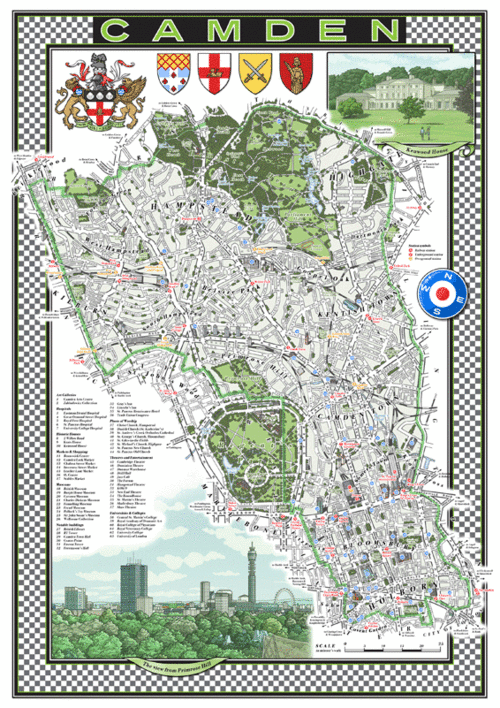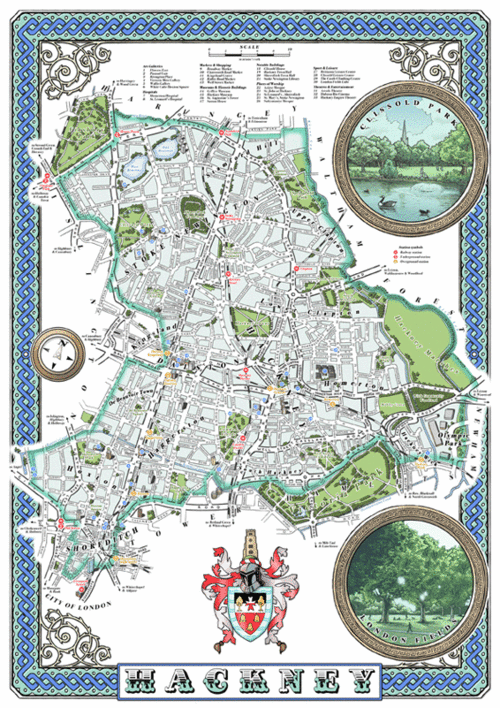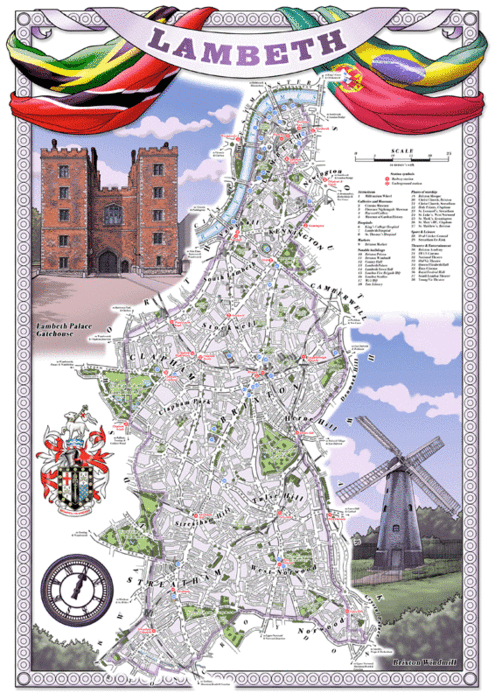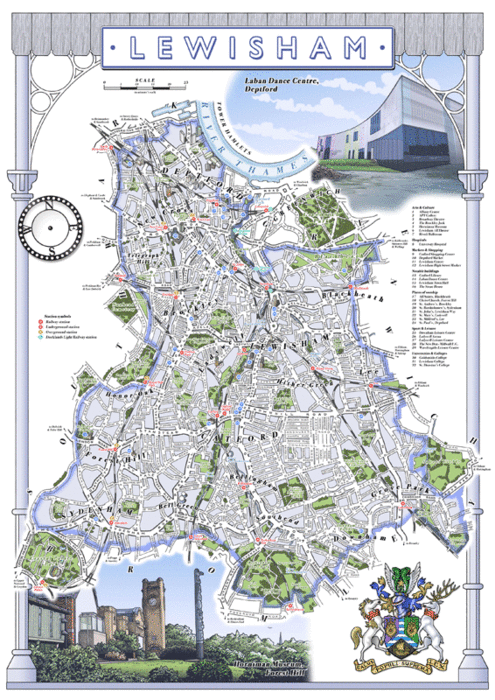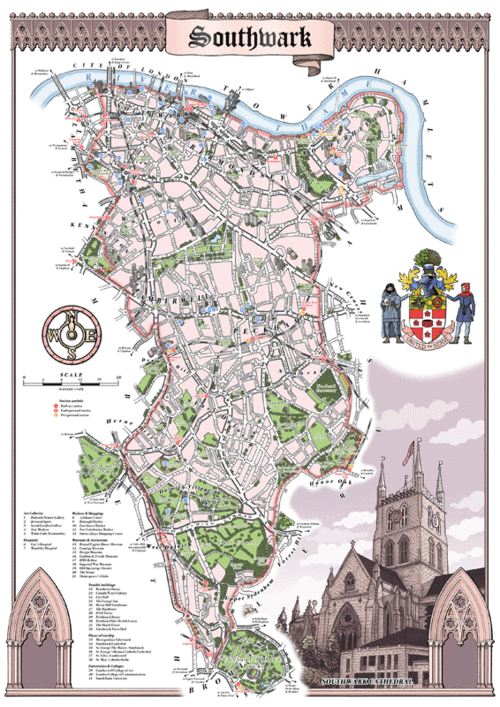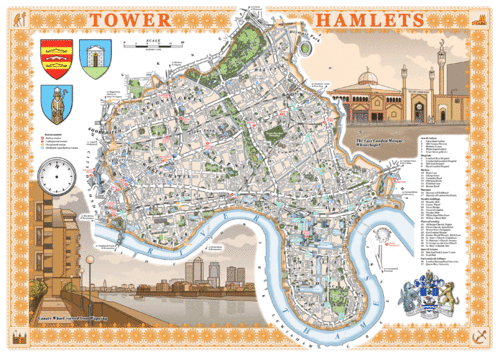Following my earlier post on Kristiina Sandoe's map / print combining landscape memory and art....
....Two more Cartographers have caught my eye. Mike Hall does excellent maps in an old tradition that incorporates pride of place within representation. In areas that require some regenereation, taking pride in an area is a crucial attribute:
....Whereas Adam Dant has a homely style and incorporates historical "map regression" to give a guide to the character of an area.
Undertaking a rare trip south of the river, cartographer extraordinaire Adam Dant presents this map of that fabled ‘terra incognita’ once known as Redriff.
1. (Twelfth century) The name of the village of Rotherhithe or “Rederheia” is thought to mean“cattle-landing place.”
2. (1016) King Cnut begins digging a trench from Rotherhithe to Vauxhall to lay seige to London, according to myth.
3. (c.1370) During the reign of Edward III a fleet is fitted out at Rotherhithe by order of the Black Prince and John of Gaunt.
4. (c.1400) Henry IV lives in an old stone house in Rotherhithe while suffering from leprosy.
5. (1485) The Lovell family, owners of the Manor at Rotherhithe distinguish themselves during the Wars of the Roses. Francis Lovell is made Lord Chamberlain - “The cat, the rat and Lovell the dog rule all England under a hog.”
6. (1587) The Queen grants Thomas Brickett “Le Gone Powder Mill Pond,” formerly possession of Bermondsey Abbey and source of Guy Fawkes’ gunpowder.
7. (1605) Shipwrights of England are incorporated under Royal Charter, so that ships “will not be made slenderlie and deceitfullie.”
8. (1620) The Mayflower is brought to Rotherhithe by its master Christopher Jones.
9. (1635) Reclaimed land and “inclosed” wharfs are claimed by poor tenants over preference to kings, lords and rich men.
10. (1684) Christopher Monck, Duke of Albemarle receives a grant for Saturday goods and merchandise market, and for a ferry at Rotherhithe.
11. (1699) John Evelyn records in his diary, “a dreadful fire destroying three hundred houses and divers ships.”
12. ( 1699) 18th October, revellers en route to the The Charlton Horn Fair disembark at Cuckold’s Point, marked by a tall pole topped by a pair of horns.
13. (1770) The St Helena Tea Gardens open in Deptford where evening music and dancing is supported by the lower classes and shipyard workers’ families.
14. (1725) The South Sea Company take the lease of the The Howland Great Wet Dock and plan unsuccessfully to revive fishing in Greenland. The dock is renamed Greenland Dock.
15. (1725) One thousand tons of “unfragrant” whale blubber are boiled and processed annually at Greenland Dock.
16. (1726) Lemuel Gulliver, Jonathan Swift’s sailor protagonist in “Gulliver’s Travels” is born at Redriff.
17. (1792) Eleven shipyards are recorded in the parish of Rotherhithe.
18. (1680) Charles II makes a “frolicksome excursion” to Rotherhithe.
19. (1777) The China Hall, previously “The Cock & Pye,” opens as a theatre with plays “The Wonder,” “Love in a Village,” “The Comical Courtship” and “The Lying Valet,” before burning down in 1778.
20. (1725) A nurseryman named Warner cultivates cuttings of Burgundy vines in the vicinity of Rotherhithe. He is – in time – rewarded with one hundred gallons of wine annually.
21. (1792) Forty acres of the parish are occupied by market gardeners famous for their produce, four hundred and seventy acres by pasture.
22. (1802) Work begins on Ralph Dodd’s ship canal, “The Grand Surrey Canal.”
23. (1809) The decline in the whaling trade and the increase in timber importing accounts for Greenland Dock being named “Baltic Dock,” later enlarged and reopened as “The Commercial Dock.”
24. (1825-42) The Thames Tunnel is bored by Sir Marc Brunel.
25. (1832) Raw materials such as hemp, iron, tar and corn from many Baltic countries, as well as timber, arrive at Surrey & Commercial Docks.
26.(1869) Rotherhithe Underground Station is opened to Wapping.
27. (1869) Dockers strike in Surrey Dicks for “the Dockers’ Tanner” a rate of sixpence an hour. The strike drew public attention to issues of poverty in Victorian London.
28. (1830) Ship breaking begins to take over from ship building in Rotherhithe with many ships built to fight in the Napoleonic Wars meeting their end.
29. (1850) Charles Lungley builds The Dane at Greenland Dock North Shipyard chartered by the French Government as transport during the Crimean War.
30. (1909) Surey Docks is taken over and reinvigorated by the newly formed Port of London Authority.
31. (1926) Only seven people arrive for work out of two thousand on the first day of the General Strike.
32. (1940) September 7th, Surrey Docks are set on fire in the first raid of the Blitz.
33. (1940) King Haakon VII, with the Norwegian government in exile and Norwegian resistance during World War II, came to worship at St Olav’s.
34.( 1940s) Dock workers play “The down the slot game” in social clubs such as “The Gordon Club.”
35. (1900-1950) Cunard white star liners trade from Greenland Dock to Canada and North America.
36. (1960) Princess Margaret meets her future husband, photographer Anthony Armstrong-Jones, in Rotherhithe.
37. (1970) Surrey Docks close.
38. (19810 Michael Heseltine, Secretary of State, forms “The Docklands Development Corporation” to redevelop the area of the former docks. It causes controversy, accused of favouring luxury developments over affordable housing.
39. (2000) Mudlarking on the foreshore yields clay pipes, oyster shells and the occasional Saxon or Roman coin.
40.( 2011) The new “super library” opens in Canada Water.
Images copyright © Adam Dant
You may like to take a look at some of Adam Dant’s other maps




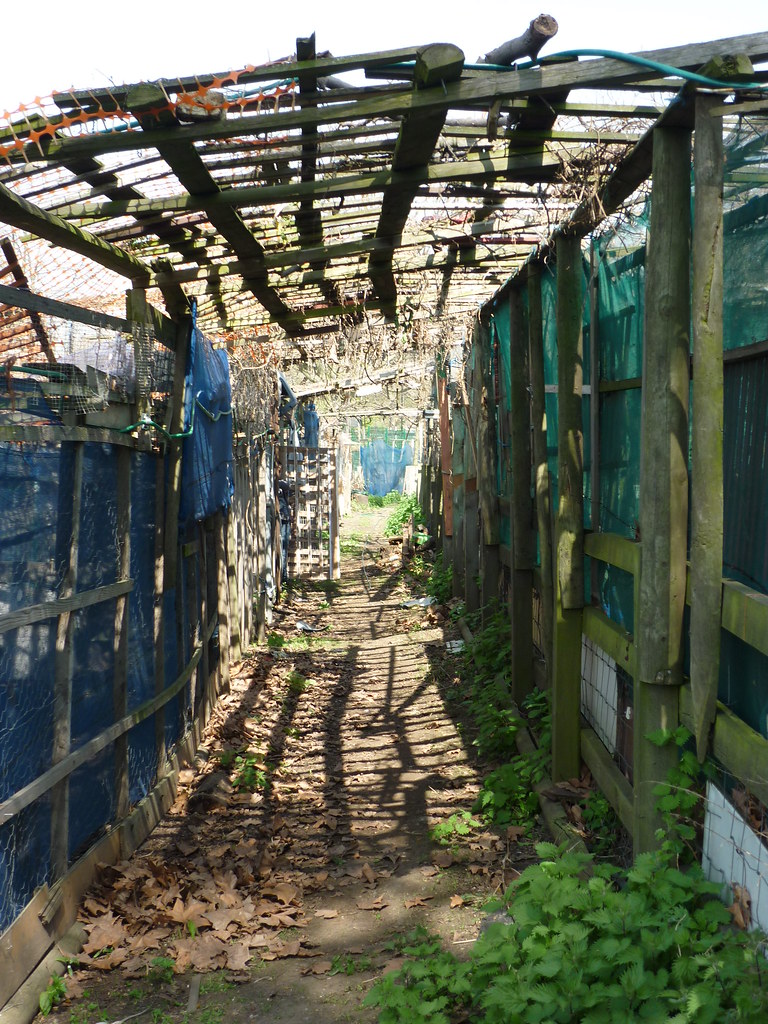



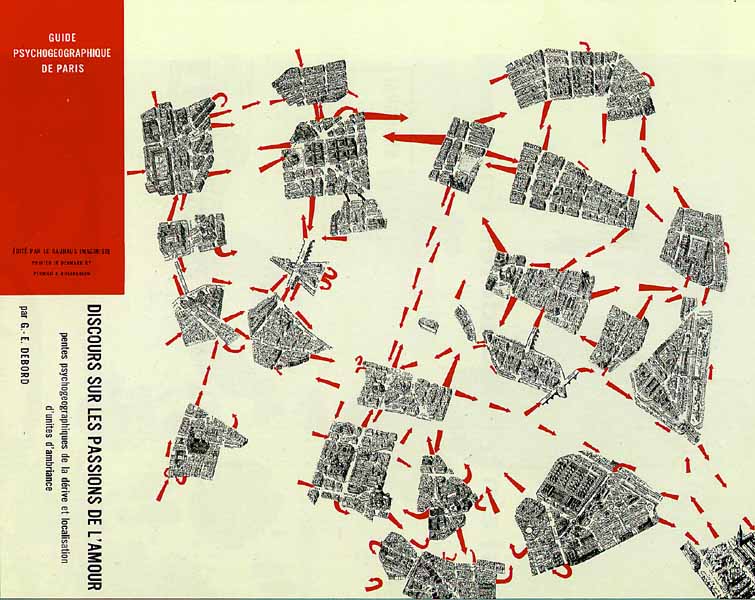

 As a reflection of European identity and diversity, the landscape is our living natural and cultural heritage, be it ordinary or outstanding, urban or rural, on land or in water.
As a reflection of European identity and diversity, the landscape is our living natural and cultural heritage, be it ordinary or outstanding, urban or rural, on land or in water.
